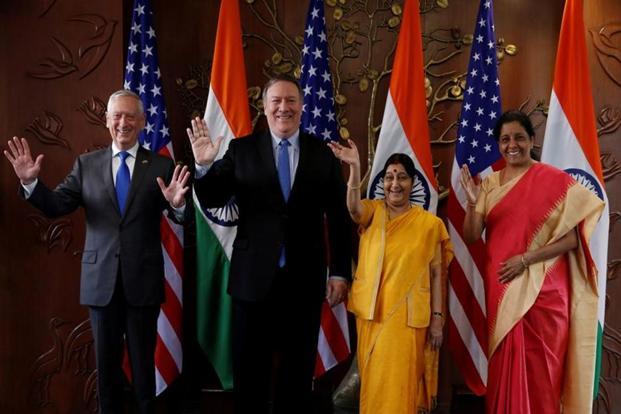First 2+2 dialogue between India-US held in New Delhi
The first edition of 2+2 dialogue between India-US held in New Delhi. In the inaugural meeting, Minister of External Affairs (MEA) Sushma Swaraj and Defence Minister Nirmala Sitharaman hosted US Secretary of State Michael R. Pompeo and US Secretary of Defence James Mattis.
2+2 dialogue
2+2 dialogue is second highest level of engagement between both countries after summit-level engagement between the Prime Minister and the US President. It was agreed between both during visit of Prime Minister Narendra Modi to US in June, 2017. It is similar to India-Japan 2+2 dialogue format between foreign and defence secretaries and ministers of the two countries.
2+2 dialogue is aimed enhancing strategic coordination between both countries and maintaining peace and stability in Indo-Pacific region. It puts strategic, defence and security relationship between two countries at forefront and centre stage. It replaced earlier India-US Strategic and Commercial Dialogue.
2+2 dialogue insulates India-US strategic relationship from feuds over trade issues and deep divide on economic integration policies as trade and commercial issues that collided with strategic relationship between both countries’ discussed in Strategic and Commercial Dialogue earlier.
Outcomes of first 2+2 Dialogue
The inaugural meeting covered broad range of bilateral, regional and global issues of shared interest, with view to strengthening strategic and security ties between two countries. Both nations also discussed strengthening of strategic, security and defence cooperation as both nations have committed to jointly address challenges in Indo-Pacific region and beyond. The dialogue is seen as vehicle to elevate strategic relationship between the two countries.
Bilateral Cooperation: Both countries committed to work together on regional and global issues. It was further decided to establish secure communication (hotlines) between two ministers and secretaries of the countries to maintain regular high-level communication on emerging developments.
Defence: India’s strategic importance of designation as US’s Major Defense Partner (MDP) was reaffirmed. It was committed to expand scope of India’s MDP status. It also mentioned offering og license exception under Strategic Trade Authorization (STA-1) to India.
Both countries also agreed to explore other means for expansion in two-way trade in defence items and defence manufacturing supply chain linkages. They also signed Communications Compatibility and Security Agreement (COMCASA).
Both countries also announced their readiness to begin negotiations on Industrial Security Annex (ISA). This will support closer defense industry cooperation and collaboration between both countries. The two sides also committed to create new, tri-services exercise. It was also agreed to increase personnel exchanges between militaries and defense organizations of both countries.
Maritime cooperation: Both countries agreed to further expand bilateral maritime cooperation. They also committed to start exchanges between US Naval Forces Central Command (NAVCENT) and Indian Navy. They also underscored importance of deepening maritime cooperation in western Indian Ocean.
Technology: Both countries acknowledged unique role of technology in India-US defence partnership. They also agreed to continue co-production and co-development of defence projects through Defense Technology and Trade Initiative (DTTI). They also welcomed conclusion of Memorandum of Intent between US Defense Innovation Unit (DIU) and Indian Defence Innovation Organization – Innovation for Defence Excellence (DIO-iDEX). They also reaffirmed on their cooperation to ensure stable cyberspace environment.
Terrorism: Both countries agreed to increase information-sharing efforts on known or suspected terrorists. They also decided to implement UN Security Council Resolution 2396 (UNSCR 2396) on returning foreign terrorist fighters. They also committed to enhance their ongoing cooperation in multilateral fora such as United Nations and Financial Action Task Force (FATF). Both countries also reaffirmed their support for UN Comprehensive Convention on International Terrorism to advance and strengthen the framework for global cooperation against terrorism.
Pakistan: Both countries called on Pakistan to ensure that its territory is not used to launch terrorist attacks on other countries. They also called on Pakistan to expeditiously bring to justice perpetrators of 2009 Mumbai, 2016 Pathankot, 2016 Uri, and other cross-border terrorist attacks.
Indo-Pacific region: Both countries spelt out that they aim at advancing free, open, and inclusive Indo-Pacific region, based on recognition of ASEAN centrality. They also mentioned respect for sovereignty, territorial integrity, rule of law, free and fair trade, good governance, freedom of navigation and overflight in the region. They also agreed support for sustainable debt financing practices in infrastructure development in the region.
Afghanistan: Both countries expressed their support for Afghan-led, Afghan-owned peace and reconciliation process. They reiterated their shared commitment to united, sovereign, democratic, inclusive, and peaceful Afghanistan. US also acknowledged India’s economic and development assistance to Afghanistan.
North-Korea: India welcomed recent US-North Korea summit on denuclearization of Korean peninsula held in Singapore. Both Countries pledged to work together to counter North Korea’s weapons of mass destruction programs.
Nuclear Cooperation: US welcomed India’s accession to Missile Technology Control Regime (MTCR), Australia Group and Wassenaar Arrangement. It also reiterated its full support for India’s immediate accession to Nuclear Suppliers Group (NSG). Both countries agreed to look forward to full implementation of civil nuclear energy partnership collaboration between Westinghouse Electric Company and Nuclear Power Corporation of India Limited (NPCIL) for establishment of six nuclear power plants in India
People-to-People Ties: Both countries recognized importance of increasing bilateral trade, investment, innovation, and job creation. They also accentuated free flow of ideas and collaboration in health, space, oceans, and other areas of science and technology.
Month: Current Affairs - September, 2018


